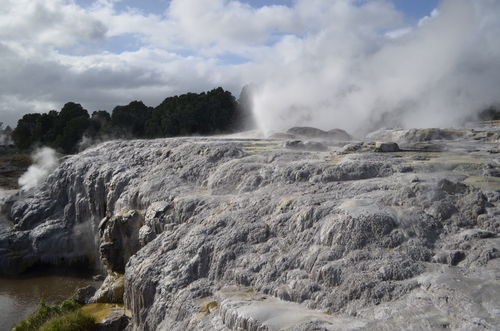Kim Macdonald's Photo Gallery
Ngatamariki Power Station
Ngatamariki thermal area, Wairakei, Taupo District, Waikato Region, New ZealandAt least from above, one of the most colourful power stations in the world, probably merely a sunlit optical illusion. Said to be the largest single binary power station in the world. Accesses the Ngatamariki geothermal field. Google Earth image.
Clark and Firth Battery Site
Waiorongomai, Matamata-Piako District, Waikato Region, New ZealandThe concrete structure is for rock crushing for a local council quarry which operated in the 1920's. The crusher closed in 1927, having processed quartz rock. The structure had been built on the Clark and Firth battery site which closed in 1912.
Craters of the Moon (from a distance)
Wairakei geothermal area, Wairakei, Taupo District, Waikato Region, New ZealandAn overview of the Craters of the Moon site. Geothermal activity started here in 1958, due to a nearby geothermal power station being established, and effecting the underground water dynamics. It contains hydrothermal eruption craters, fumaroles, and minor mud pools, but not the geysers, colourful sinter deposits, and other star attractions of some other geothermal fields in the region. The picture also shows the unique vegetation found in these geothermal areas, that can cope with the extreme conditions.
Potahu Geyser
Te Puia, Rotorua District, Bay of Plenty Region, New ZealandThis is not taken when it erupts, which is apparently 30 metres high. At other times it hisses and spits. Reliably informed by the entrance staff while they were taking my money, the geyser erupts numerous times per day, I stood next to it for two hours, while the geyser acted like a diva and refused to perform. A watched pot never boils as Benjamin Franklin said.
Lake Rotorua
Lake Rotorua Area, Rotorua District, Bay of Plenty Region, New ZealandAround 200 000 years ago major volcanic eruptions caused the ground to collapse, forming a 16 kilometre wide caldera, now partly filled by Lake Rotorua. In the background is Mokoia Island, a rhyolite dome, formed later by slowly oozing lava in the caldera. In the foreground is part of the Ohinemutu Maori village, in particular the meeting house and 1914 St Faiths Church. Both are beautifully decorated with Moari carvings. This Maori village is occupied by the Ngati Whakaue tribe, and is the original settlement before all the tourists arrived. It is a 10 minute walk from downtown Rotorua. The village can be walked around for free, but please show respect, and be unobtrusive. Surrounding the village are hot springs and steam vents as can partly be seen in the photograph.
Sugar Loaf Islands
Sugar Loaf Islands, New Plymouth, New Plymouth District, Taranaki Region, New ZealandOn a cold blustery winters day. Type locality for taranakite, a phosphate mineral formed from the interaction of clays and bird guano in damp conditions. The island to the right is Motumahanga, then to the left Moturoa, and the pinnacle on the mainland is Paritutu. Also seen is the power station chimney at the New Plymouth port. There are three other islands in the group not part of the photograph.
Gemstone Beach Gold Placer Deposits
Gemstone Beach, Orepuki, Southland District, Southland Region, New ZealandGold and other treasures may at times be found along the beach which is open to the public. Maybe stay out of the mining claim though right next to the car park.
Arrowtown Chinese Settlement
Arrowtown, Queenstown-Lakes District, Otago Region, New ZealandThe Otago Provincial Government had encouraged Chinese miners to emigrate, after several fields became deserted after the 1862-1863 gold rushes. Miners had left for the newly discovered gold fields on the West Coast, which may have not been any better, but the grass is always greener.... Not everyone was happy with large numbers of Chinese arriving on the Otago gold fields. Most were from the Canton area. In some areas they consisted of about half the miners. They often took over abandoned claims from other miners, and many found little gold, or much money to send back to their families in China. A short walk from the main street in Arrowtown, are several stone cottages, hut ruins, old garden walls etc from the Chinese settlement here, with interpretative panels.













